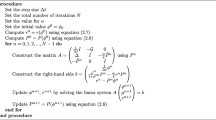Abstract
In Part I [1], we introduced the idea of a Lax pair and explained how it could be used to obtain conserved quantities for systems of particles. Here, we extend these ideas to continuum mechanical systems of fields such as the linear wave equation for vibrations of a stretched string and the Kortewegde Vries (KdV) equation for water waves. Unlike the Lax matrices for systems of particles, here Lax pairs are differential operators. A key idea is to view the Lax equation as a compatibility condition between a pair of linear equations. This is used to obtain a geometric reformulation of the Lax equation as the condition for a certain curvature to vanish. This ‘zero curvature representation’ then leads to a recipe for finding (typically an infinite sequence of) conserved quantities.
Similar content being viewed by others
Suggested Reading
G S Krishnaswami and T R Vishnu, The idea of a Lax pair — Part I: Conserved quantities for a dynamical system, Resonance, Vol. 25, No. 12 pp. 1705–1720, 2020.
D J Griffiths, Introduction to Quantum Mechanics, Second Edition, Pearson Education, Dorling Kindersley Indian Ed., New Delhi (2005).
P G Drazin and R S Johson, Solitons: An Introduction, Cambridge University Press, Cambridge, 1989.
A Das, Integrable Models, World Scientific Publishing, Singapore (1989).
T Miwa, M Jimbo and E Date, Solitions: Differential Equations, Symmetries and Infinite Dimensional Algebras, Cambridge University Press, Cambridge, 2011.
P D Lax, Integrals of nonlinear equations of evolution and solitary waves, Comm. Pure Appl. Math., 21, 467, 1968.
L D Faddeev and L A Takhtajan, Hamiltonian Methods in the Theory of Solitons, Springer-Verlag, Berlin, 1987.
Acknowledgements
We thank an anonymous referee for useful comments and references. This work was supported in part by the Infosys Foundation, J N Tata Trust and grants (MTR/2018/000734, CRG/2018/002040) from the Science and Engineering Research Board, Govt. of India.
Author information
Authors and Affiliations
Corresponding authors
Additional information
Govind Krishnaswami is on the faculty of the Chennai Mathematical Institute. He works on various problems in theoretical and mathematical physics.
T R Vishnu is a PhD student at the Chennai Mathematical Institute. He has been working on integrable systems.
Rights and permissions
About this article
Cite this article
Krishnaswami, G.S., Vishnu, T.R. The Idea of a Lax Pair-Part II. Reson 26, 257–274 (2021). https://doi.org/10.1007/s12045-021-1124-1
Published:
Issue Date:
DOI: https://doi.org/10.1007/s12045-021-1124-1




